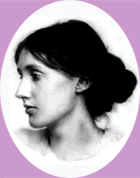"As a woman I have no country. As a woman I want no country.
As a woman my country is the whole world."
Virginia Woolf

Introduction
Virginia Woolf's novels are strewn with recurring images and symbols. These repeated images are important glimpses into the mindset of a very complex woman who grappled with issues of self-identity, love, marriage, religion, aging, life, death and many more. These images were specifically chosen to represent certain themes and ideas she wanted to share with audiences who were reading her books. Although she was influenced by many elements in her life, including her childhood, the Bloomsbury group, social issues, the world wars, and her education, many of her images can be traced back to the idea of the feminine.
Since there is so much that can be derived from Woolf's novels, it is important to have a focal point, an idea of when and where one should limit the research involved After reading all of her major novels, I decided to focus my critical analysis on Mrs. Dalloway (1925) and To the Lighthouse (1927). My focus will be the images of clocks, sounds, and time that herald a change in the women's relationships within each of the novels. I will also explore ideas of nature and the feminist language that is integrated in Woolf's language, such as the sea, waves, and the lighthouse.
Instead of focusing solely on the images from the novels, I look at the symbols and the idea of the feminine in conjunction with certain relationships. Mark Hussey, in his critical examination of Woolf's works, explains that "it is in relationships with others that the possibilities and limitations of human being are realized, and it is against the background of others that individual identity stands out" (46). Most of the relationships in Woolf's novels can be broken down into pairs, husband and wife, parent and child, lovers, friends, an old and a young person, and male and female. Though Woolf's works highlight knowledge, and the impossibility of knowledge, it is through the meaningful relationships, the communications, whether expressed verbally or in thought, that the reader is given a sense of who these people are and what they are striving for in life.
Work Cited
Hussey, Mark. The Singing of the Real World: The Philosophies of Virginia Woolf's Fiction. Columbus: Ohio State UP, 1986.